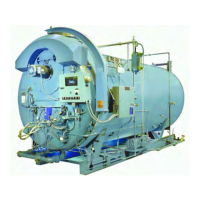Chapter 5 — Starting and Operating Instructions
5-14 Part No. 750-184
On ignition failure, the flame failure light will glow and the blower
will purge the boiler of unburned fuel vapors before stopping. After
ignition failure, wait a few moments before re-setting the lockout
switch.
Do not re-light the pilot or attempt to start the main burner, either
oil or gas, if the combustion chamber is hot and/or if gas or oil vapor
combustion gases are present in the furnace or flue passages.
Failure to follow these instructions could result in serious personal
injury or death
The burner and control system is designed to provide a “pre-purge”
period of fan operation prior to establishing ignition spark and pilot
flame. Do not attempt to alter the system or take any action that
might circumvent the “pre-purge” feature. Failure to follow these
instructions could result in serious personal injury or death
After main flame ignition, the burner should be set on manual
control at its low fire setting (that is, with manual flame control at
“close”) until the boiler is properly warmed. Close the steam header.
In the case of a steam boiler, CLOSE THE TEST VALVE when steam
begins to appear.
A hot water boiler must have a continuous flow of system water
through the vessel during the warm-up period. The entire water
content of the system and boiler must be warmed prior to increasing
fuel input.
If the flame at low fire provides insufficient heat to reach normal
operating pressure or temperature after 30 minutes, gradually
increase the firing rate by turning the Manual Flame Control in one
point increments to no higher than the third cam screw. Operate at
the increased fuel input rate for a period of time until an increase is
noted in pressure or temperature.
After the boiler is thoroughly warmed, turn the manual flame control
to high fire. At this point a combustion analysis should be made,
with instruments, and fuel flow regulated as required. Refer to the
adjustment procedures in Chapter 6. After making the high-fire
adjustment, manually decrease the firing rate, stopping at each cam
screw to analyze combustion gases, and adjust as required.
To properly perform the testing and adjusting, it is necessary that
the burner be allowed to fire at a maximum rate long enough to
achieve desired results.
Operating - Normal operation of the burner should be with the
switch in the automatic position and under the direction of the
modulating control. The manual position is provided for initial

